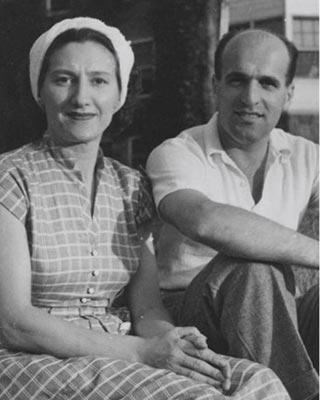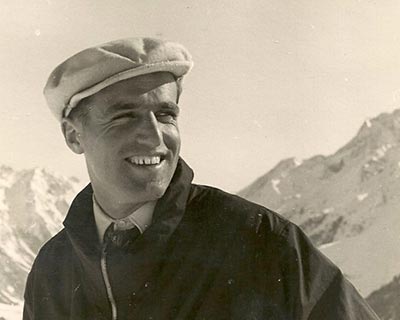Frederick Blodi was born on Jan. 11, 1917 in Vienna and grew up in the southern suburb of Maria Entzesdorf. His father was a corporate lawyer for the large multinational construction firm, the Nobel Dynamite Co.
 Frederick and Ottilie Blodi
Frederick and Ottilie Blodi
While in kindergarten, Dr. Blodi met his high school sweetheart and future wife, Ottilie. Following graduation from the “gymnasium” (“high school”), Dr. Blodi enrolled in the University of Vienna Medical School, graduating in 1940. Near the end of medical school, he was drafted by the German Wehrmacht (Austria had been annexed into the German Third Reich in 1938) and put into an anti-tank unit.
Such units were known for sustaining extreme casualty rates in combat. After six months, Dr. Blodi was released from this unit and placed into a medical corps until graduation. After graduation, Dr. Blodi trained in pathology and general surgery. While assisting and providing anesthesia he was able to sample all surgical specialties. His experiences with the famous retinal surgeon, Karl Safar, led Dr. Blodi to choose a residency in ophthalmology at the University of Vienna.
During the latter years of World War II, Dr. Blodi recalled that he and his colleagues would eat lunch on the lawn outside the university hospital, enjoying the sight of Allied bombers flying northward overhead, en route to their targets in Germany. On one occasion, the doctors suddenly realized that their hospital was the target of the bombs and had to rush inside to help move patients into safer locations.
As the war ground on, many Austrian soldiers attempted to avoid active duty by self-inflicting disabling wounds, such as arm or rib fractures. Dr. Blodi was recruited to help such efforts by a young woman he had previously treated for a skiing injury. Dr. Blodi provided others with ether anesthesia and instructions as to how to break their own bones.
Why did he do such a thing? Gunter von Noorden, MD, a German-born and raised ophthalmologist who trained at Iowa in the 1950s recalled that Dr. Blodi told him: “I just felt so sorry for those boys, who[m] I knew would be killed sooner or later in this war.” For this anti-war effort, Dr. Blodi was arrested in 1944 and convicted. He was sentenced to serve eight years in the Nazi-run military prison in Stein, on the Danube river.
 Frederick Blodi, MD, was born in Austria.
Frederick Blodi, MD, was born in Austria.
In the chaotic days of April 1945, as the Soviet army began to sweep into Austria, the prison guards abandoned their posts. The prison commander allowed the cells to be opened and the prisoners freed. Almost all of the prisoners left on foot, only to be massacred when SS soldiers encountered them in the nearby small town of Habersdorf. Dr. Blodi survived because he had stayed behind in the prison to help tend to sick and infirm prisoners who were not able to leave their beds, as he had become the de facto doctor for the inmates. These remaining prisoners, including Dr. Blodi, were again placed under Nazi control and moved to the town of Suben.
When the Allied forces liberated Suben, the remaining prisoners were freed. Dr. Blodi recalled that he and another prisoner took a small boat and floated and rowed their way downstream to Vienna. Dr. Blodi returned to the hospital where had previously worked (the Allgemeines Krankenhaus) and was allowed to go back to his former duties. Vienna, like Berlin, was divided into four parts to be controlled by the American, Soviet, British and French allied forces. By this time the hospital had been placed under British army control.
It was at this time that he again met his fiancée, Ottilie Schmakal. Because of the threat of impending war, Ottilie had moved to New York City in 1938, where her mother had moved after remarrying. While in New York, Ottilie became an American citizen, enlisted in the Women’s Army Corps and served as a translator after the war, helping interrogate German officers in Germany and Austria. She and Dr. Blodi had not been able to communicate throughout the war years, and Ottilie did not know if Dr. Blodi was even alive or where he might be. She went to Vienna and to the hospital where he had always worked and simply found him there. Shortly after, in 1946, the two were married in the Imperial Chapel in Vienna. As Schmakal was still an American soldier, permission had to be granted to marry an Austrian by her commanding officer, Gen. Mark Clark.
In 1947, Dr. Blodi was selected as one of the first United Nations World Health Organizaton fellows. Allowed to choose anywhere to continue his medical training he picked New York City. This was because his wife had lived there and loved New York and because the only Austrian ophthalmologist that he knew of in the United States – Ludwig von Sallman – was in New York at the famous Harkness Eye Institute, a part of Columbia University and the Columbia-Presbyterian medical complex. Dr. Blodi and his wife sailed to New York separately per military regulations in November 1947.
Dr. Blodi became a research fellow with renowned ophthalmologist, Algernon Reese, MD. Reese was most well-known for his work in ocular oncology, including choroidal melanoma and retinoblastoma but also maintained a busy general ophthalmic practice and frequently saw celebrities from worldwide destinations. In many ways, Reese was probably the most sought-out ophthalmologist of his time. Initially, Dr. Blodi worked in the pathology laboratory, but quickly added clinical and surgical time with Reese. Reese’s legendary gentlemanly Southern style included inviting Dr. Blodi to join him in various sports activities: tennis, swimming at Reese’s pool, etc.
One day in the pathology lab stood out from all of the others. Various patient cases were being reviewed by analyzing the microscopic pathology. During the discussion of one slide, Reese turned to Dr. Blodi and asked, “Fred, what do you think?”
Dr. Blodi was astonished. He recalled “never before had a man of such eminence asked me for my opinion.” This was in marked distinction from his experiences in Europe where the higher-ups of the department never asked for an opinion from the younger physicians. In fact, it was often frowned upon for the younger doctors to even ask their superiors questions about patient care. Dr. Blodi realized that this open form of communication was far better for both medical education and patient care.
During the late 1940s, clinicians noted that an apparently new retinal disease was affecting prematurely born infants. Many children were blinded by what was termed retrolental fibroplasias (RLF, now called retinopathy of prematurity or ROP). Babies Hospital on the Columbia-Presbyterian medical campus was already a well-respected site for neonatal care, mainly due to the pioneering work of pediatrican William Silverman, MD. Silverman and Reese recognized the need to screen prematurely born infants for this new condition, and Dr. Blodi was selected to perform the examinations, both at Babies Hospital and at affiliated Lincoln Hospital in the Bronx. On Feb. 15, 1950 Dr. Blodi noted in the chart of an 8-week old infant: “increased tortuosity of (retinal) veins!” This was the first case of RLF seen in New York.
Dr. Blodi suggested treating this infant with the new “wonder drug” ACTH. With ACTH treatment, the infant’s eyes “returned almost to normal,” and the child was discharged. A clinical trial of ACTH therapy was instituted at Babies Hospital and many children did well with regard to their retinas, although the drug caused numerous severe systemic side effects. Untreated infants at Lincoln Hospital seemed to fare worse. Then Dr. Blodi made a remarkable observation: Some affected, but untreated infants were found to have spontaneously regressed disease. This prompted a more careful and longer-term study which showed that the drug had no true effect on the retina and, in fact, caused more systemic side effects, including higher death rates. Only later would high blood levels of oxygen be implicated in the cause of the disease.
During this happy and productive time, Dr. Blodi suffered yet another fatal setback. While giving an oral presentation Dr. Blodi began to cough and could not stop. He had to terminate the talk and was hospitalized. The diagnosis of laryngeal tuberculosis was made. Dr. Blodi was transferred to the world-famous Saranac tuberculosis center in upstate New York. It was here that he was cured of the disease when streptomycin therapy was instituted. Dr. Blodi continued academic work while at Saranac. His Harkness Eye Institute colleague, Ira Jones, MD, recalled that Reese and Dr. Blodi would correspond by mail on research and publications. As was typical of Reese’s generous personality, Reese would often visit Dr. Blodi and would frequently press money into Otty Blodi’s hands when he departed.
In 1952 Dr. Blodi realized that he might have to leave New York. He could not obtain a permanent medical license from the state because his medical school transcript seemed to be short of the required years. This had occurred because of the compressed schedule and full-year calendar used in Vienna during the war to more rapidly educate physicians. Dr. Blodi interviewed at medical centers outside of New York. The most compelling job offer came from Dr. Alson Braley at the University of Iowa. While at Columbia, Braley had befriended Dr. Blodi, and Dr. Blodi said that “never before had I met anybody with such infectious optimism, cordiality and obvious honesty. Well, I just had not met a true Midwesterner before.” Dr. Braley had recently returned to his home state of Iowa as the chairman of the department and offered Dr. Blodi a faculty position. Dr. Blodi accepted immediately and by November 1952 was in Iowa City, Iowa.
Dr. Blodi’s move to Iowa City heralded the start of another phase of his career, one which included becoming department chairman in 1967 and president of the American Academy of Ophthalmology in 1979 when the organization split away from the otolaryngologists. Dr. Blodi began his academic career as the ophthalmologist-in-chief for the Veteran’s Hospital in Iowa City, where he grew to love clinical teaching. For example, Dr. Blodi started weekly ocular pathology quizzes for the residents. When there was an especially difficult pathology case for the residents to solve, he would bring in a six-pack of beer to any resident with the correct answer. He also organized tennis matches and monthly poker games that helped bond the faculty, fellows and residents within the Department of Ophthalmology.
In 1994, Dr. Blodi suffered a disabling stroke. On Oct. 30, 1996, he died in Iowa City after a second stroke. Dr. Blodi will always be remembered as someone who welcomed physicians from around the world with open arms, some as visitors and some as new faculty, and who also brought residents and faculty together.